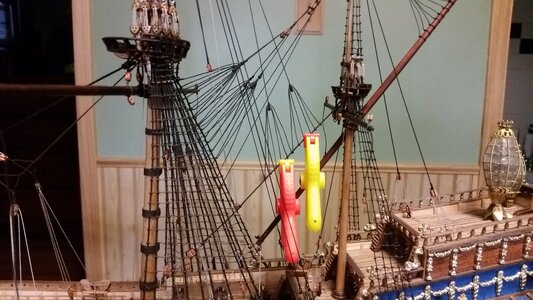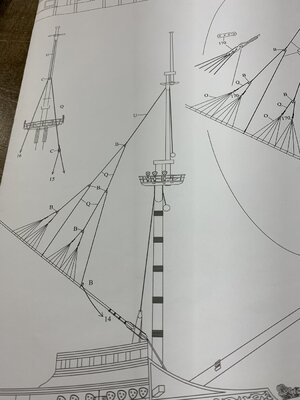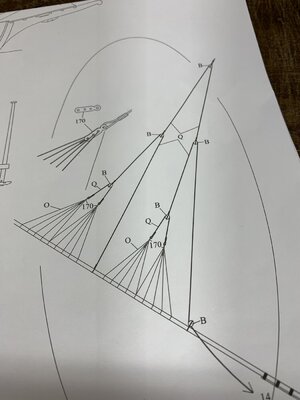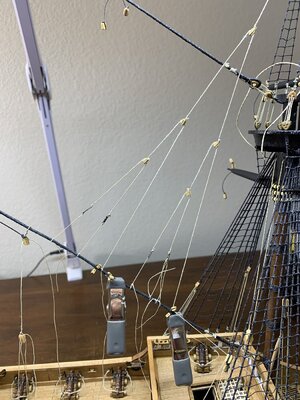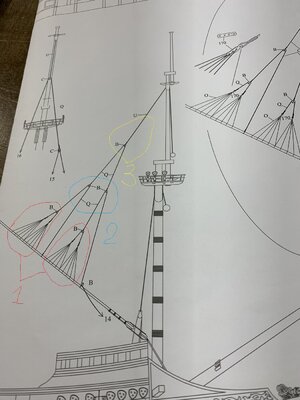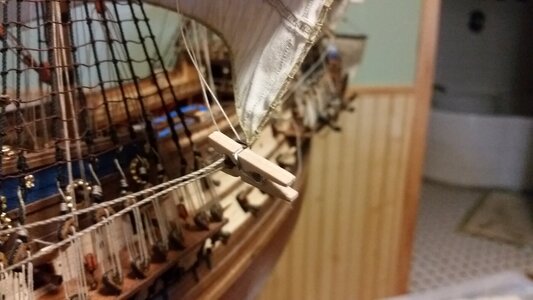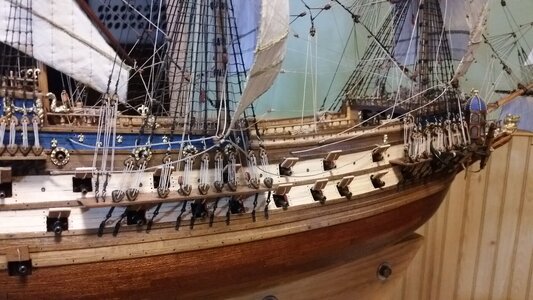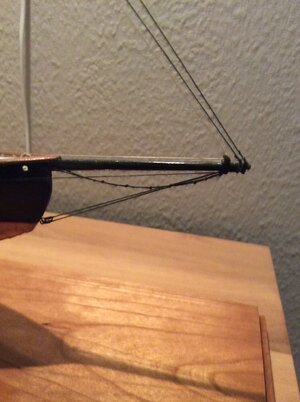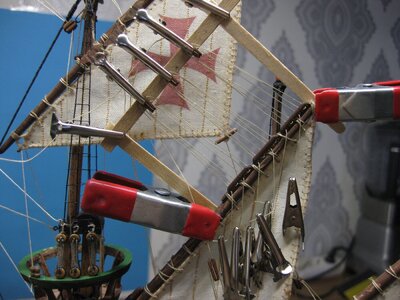Attached are photos of the point I’m at in rigging the Amati Revenge. I’ve been working on this for 2 weeks with no luck. Whenever I move one line some or all other lines move or sag. Is there a trick or secret to accomplishing this? I would so appreciate any help you good folks could give me.
Thank you
Mike
Alexander74's approach to start rigging at the bowsprit and move upward to the upper end of the stay is the best approach. Here are some details on how to make the crow's feet while suspending the upper portion of the stay line in a temporary fashion so you can work on the line easily:
The crow's foot was rigged as follows. The euphroes were lashed to each end of a segment of line, which also passed through a 5mm block. A long length of 0.30mm line was attached to the block, and the other end of it was clamped temporarily to the top of the fore topmast. The length of this line was adjust to place the block and two euphroes at the proper distance from the bowsprit. To make sure that the lines are all equally taut in a Dutch style crow's foot stay, you start work at the bowsprit and work toward the large 7mm block at the end of the stay line. Several short segments of 0.30mm black line were cut for the lines that pass through the euphroes. You start with the line centermost relative to each euphroe, which is the line that passes through the last hole in the euphroe at its bottom end. For each line,you tie the forward end to the bowsprit with a slip knot so it stays tight on the bowsprit. Add a tad of glue to this knot. Then you pass it through the euphroe rearward and secure it to the bowsprit with an overhand bend followed by a half hitch. When the forward most euphroe line is secure by one line, run a similar line through the end of the second euphroe at the rear. Adjust the length of this line so that both euphroes are equidistant from the 5mm block above. The lanyard off the 5mm block must have enough tension to allow you to see the angles of the lines and the placement of the euphroes.When the forward most euphroe line is secure by one line, run a similar line through the end of the second euphroe at the rear. Adjust the length of this line so that both euphroes are equidistant from the 5mm block above. The lanyard off the 5mm block must have enough tension to allow you to see the angles of the lines and the placement of the euphroes.When the forward most euphroe line is secure by one line, run a similar line through the end of the second euphroe at the rear. Adjust the length of this line so that both euphroes are equidistant from the 5mm block above. The lanyard off the 5mm block must have enough tension to allow you to see the angles of the lines and the placement of the euphroes.
Now rig the lines for through the next hole up in each euphroe. Take care to tension each euphroe line so that the previous line does not go slack from over-tightening the next line. all three lines in each euphroe must have equal tension. This is critical if the end result is to look good. It takes several tiny adjustments making the second knot in each euphroe line and the position of the loops around the bowsprit to get everything even, so don't cinch the knots tight or apply glue until you are sure the tension is right.
When the euphroe lines are done, unclamp the 0.3mm line from the mast, and pass it through the center of a 7mm single block. You can now choose the position of the 7mm block, and lash the end of the 0.5mm stay line to the block. The take the end of the 0.30mm line and pass it through the 5mm block that was lashed to the bowsprit just behind the spritsail topmast top. run the line rearward along the bowsprit and tie it to the cleat on the side of the bowsprit over the bow deck.
Making euphroes, which are used more often than blocks on early vessels.
Tying a stay line portion to the euphroe.
The position of the euphro is established using a clamp until the first of the lowest line segments is tied off to the bowsprit.
While tying the lowest segments of the stay, the upper end is held temporarily with a clamp to the masthead.
Each loop for the lowest is made and adjusted by making and re-making the knots on the bowsprit to get the tension just right. Start with the segment at the center of the crow's foot, the line that passes through the lowest hole in each euphroe. Rig these centermost lines for each euphroe before rigging the lines higher and lower on the bowsprit.
Note that the euphroes are both at the same height relative to the stay line. Once tension of all lines is acceptable, lock the lines and the knots in place with watered down PVA glue.
Now that the lower crow's feet are complete, rig the upper portions of the stay. Tie the upper end of the stay around the masthead, and tension the completed stay by tying off the lanyard for the stay to the belaying point. You can see this lanyard coming down above the crow's feet and passing through the block stropped to the bowsprit just behind the top for the sprit topsail. In this case, the line runs aft and is belayed to a cleat on the rear end of the bowsprit.
Here is a picture of where the top end of the stay is tied, on the masthead of the fore topmast.
You can see the entire fore topmast stay and the blocks and euphroe positions.
The example above was a forestay with crow's feet. The same method is used for backstays with crow's feet on early vessels like HMS Revenge. When any lines are attached to stays, or in the case below, the rear shrouds, make your best effort to not over tighten the line such that the stay or shroud are pulled out of position. As you attached more lines to the stays, they will get pulled father and farther out of position if you have too much tension on the lines. Try to keep the stays as straight as possible.
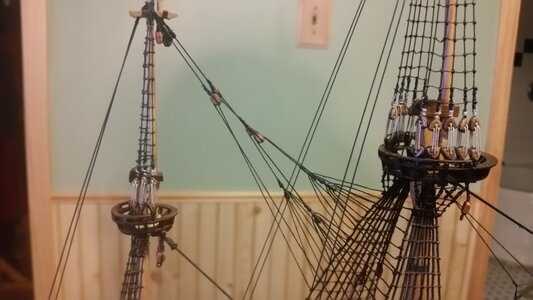
Watered down glue applied to the crow's feet, and allowed to dry while the clamps add weight to the stay they are tied to, will stiffen the lines so they retain their shape with sharp bends at the points where they pass through the euphroes. The example below is my first time rigging crow's feet, and it's not the best, but it's good enough.
